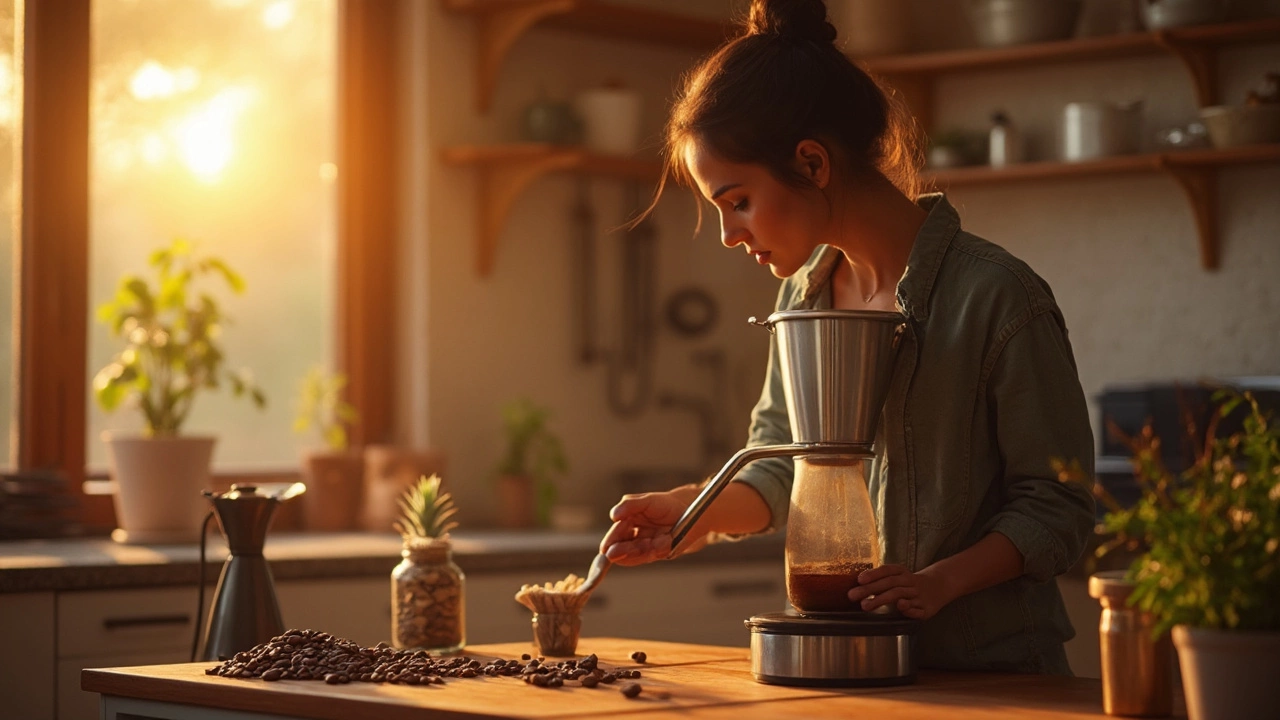
Ever added up what you spend at coffee shops every month? It might surprise you how fast it adds up—sometimes even more than your Netflix, gym, and Spotify combined. But is switching to home-brewed coffee really the magic fix everyone claims?
If you're eyeing your favorite café's prices and wondering if that shiny espresso machine will save you money in the long run, you're not alone. There’s loads more to consider than just costs. What about flavor? The time it takes? And let's be honest: are those fancy home machines really a bargain, or just another kitchen gadget gathering dust?
Right now, deals on coffee makers are everywhere, but not every 'bargain' is truly a good buy. Before you open your wallet, let’s look at what really changes if you make the jump and start brewing at home. You'll find cost comparisons, taste insights, and a few tricks for landing a quality machine without overpaying. It’s all about making your morning cup smarter—not just cheaper.
- Crunching The Numbers: Home Brew vs Café
- Taste & Quality: Can Home Coffee Compete?
- Saving Time (and Your Sanity) in the Morning
- Finding the Right Machine Without Breaking the Bank
Crunching The Numbers: Home Brew vs Café
Let’s get real about the money side. Buying coffee at a café every day seems cheap—until you actually do the math. The average café latte in the U.S. clocks in around $4.50. If you grab one every weekday, you’re out about $22.50 a week or nearly $1,170 a year. That’s just for the basic stuff, not even those syrup-laden, extra-shot specials.
Now, what about making coffee at home? Say you pick up a decent bag of beans for $15, which gives you about 20 cups. Add in basic costs for filters, water, and a bit of milk, and you’re paying roughly $1 per cup (sometimes even less if you buy in bulk or choose simpler beans).
| Item | Daily Café | Home Brew |
|---|---|---|
| Cost per cup | $4.50 | $1.00 |
| Monthly total (22 workdays) | $99 | $22 |
| Yearly total | $1,170 | $264 |
Yeah, that’s a gap you can’t ignore. Even if you splurge on a $300 coffee maker, it pays for itself pretty quickly—usually in just a few months. And if you spot one of those seasonal coffee machine deals, you can knock that starting price down even more.
Just keep in mind, you’ll have to pay up front for gear—the coffee maker, grinder (if you want), maybe a frother. But after that, the ongoing costs are way lower and way more predictable. Plus, you get the bonus of never having to awkwardly spell your name on a cup again.
Taste & Quality: Can Home Coffee Compete?
The obvious question: does making coffee at home taste as good as café coffee? Honestly, it depends—but you can get really close, and sometimes even better, with a few smart moves.
First, the main difference comes from the beans. Cafés use fresh beans and grind right before brewing. If you do the same at home—buy whole beans and grind them before brewing—you set yourself up for a major flavor win. Pre-ground coffee loses its punch quickly.
Water matters, too. Around 98% of your cup is water, so if your tap water tastes weird, your coffee will, too. Lots of folks use filtered water at home for this reason, and it's one of the easiest upgrades for people chasing café taste in their kitchen.
Here’s a quick breakdown comparing typical home and café setups:
| Factor | Home Setup | Café |
|---|---|---|
| Bean Freshness | Varies (fresh if you buy whole beans) | Always fresh; high turnover |
| Grind Size | Depends if you have a grinder | Custom for each brew |
| Water Quality | Tap or filtered | Usually filtered |
| Equipment | Ranges from basic drip to fancy machines | Commercial-grade machines |
| Barista Skill | Learning curve | Professionally trained |
Don’t think you need a $1,000 espresso machine for good home brewing. Even a budget-friendly pour-over or French press can easily beat some chain cafés if you use fresh beans and decent water. Plus, you control every step, so you can tweak things until it tastes just right for you.
One surprising perk to brewing at home is the freedom to experiment. Want it stronger, smoother, or with a dash of cinnamon? No problem. Try out different coffee-to-water ratios, water temperatures (195–205°F is the sweet spot), or even grind sizes. Tiny changes can make a huge difference.
If you’re after café-level espresso, look for machines with a solid 9 bars of pressure (that’s the industry standard for real crema and authentic flavor). Coffee machine deals often pop up on models that do this without costing a fortune.
Bottom line: home coffee can absolutely compete on taste and quality. A little practice and some good beans go a long way. You might just find that your morning cup starts tasting even better than what you used to grab on your commute.

Saving Time (and Your Sanity) in the Morning
Mornings can be chaos—especially if you’re scrambling for a decent cup before heading out. Making coffee at home means you skip the lines, avoid rush hour panic, and get your caffeine fix before anyone else is even awake.
The time you save isn’t just a hunch. According to a 2023 survey by the National Coffee Association, the average American spends about nine minutes waiting in line for their daily brew. Add in driving or walking to the shop, placing your order, then waiting for your drink—easily 20 minutes, gone. When you brew coffee at home, it often takes less than five minutes, even with a fancier machine.
| Activity | Time (Average Minutes) |
|---|---|
| Waiting in coffee shop line | 9 |
| Walking/driving to café | 6 |
| Ordering & drink prep | 5 |
| Making coffee at home | 5 |
If you’re tight on time, check out machines with auto-timers. Set them up the night before, and you’ll wake up to fresh coffee—no zombie mode required. Some home brewing systems even let you use your phone to start the process right from bed.
Here are some tips for saving even more time (and patience):
- Grind your beans ahead of time and store in an airtight container.
- Use reusable filters so you’re not fumbling with paper ones at 6 a.m.
- Fill the water reservoir after each brew, so you don’t forget when you’re half-awake.
- Prep your mug the night before—yes, really. It’s one less thing to grab when you’re rushing out the door.
Honestly, making coffee at home can turn the most hectic morning into a ritual that’s fast, fuss-free, and way less stressful. Once you’ve got your routine down, you’ll wonder how you ever survived those café lines.
Finding the Right Machine Without Breaking the Bank
Not all coffee machine deals are created equal. You don’t need to shell out hundreds for your morning fix—unless you really want to play home barista. Right now, big stores like Best Buy, Target, and even Amazon run regular promos on popular machines. Nespresso, Keurig, and even entry-level espresso makers from brands like De’Longhi and Breville often drop below $100 around holidays or big sale events like Prime Day.
If you mostly want speed and convenience, pod machines (like Keurig and Nespresso) are tough to beat. They’re often marked down and, for $60–$100, you’ll get a decent brew without fuss. Just know you might end up spending more on pods compared to ground coffee or whole beans over time.
For folks who crave that classic drip coffee, stick to reliable brands like Mr. Coffee or Hamilton Beach. You can snag a solid drip machine for less than $40, and they’re basically bulletproof. If you’re dreaming of espresso but don’t want to go broke, budget espresso makers (think De’Longhi EC155) regularly appear for under $100. They won’t completely match that $6 café shot, but once you dial in your technique, they get pretty close for the price.
Want to get the best bang for your buck? Here’s what to watch for before buying any coffee machine deals:
- Check online reviews—look for consistent complaints about durability or taste.
- Keep an eye on return policies and warranty (especially with pricier machines).
- Don’t get sucked in by features you’ll never use; basic machines often last longer and brew better.
- Buy bundles only if you need what’s included (grinders, frothers, mugs), otherwise you’re paying extra for stuff that’ll just clutter your kitchen.
- Set a price alert on deal sites or use browser extensions to catch price drops—sometimes savings happen overnight.
To give you a sense of current deals, check out this quick snapshot of popular machines and average 2025 sale prices:
| Machine | Type | Average Sale Price | Notable Features |
|---|---|---|---|
| Keurig K-Express | Pod | $59 | Fast brew, dishwasher-safe parts |
| Mr. Coffee 12-Cup | Drip | $29 | Simple controls, brew pause |
| Nespresso Vertuo Pop+ | Pod Espresso | $89 | Centrifusion tech, auto size detection |
| De’Longhi EC155 | Espresso | $89 | 15-bar pressure, manual frother |
Buying a machine doesn’t have to wreck your wallet. Focus on your actual coffee routine, look for simple, durable models, and pounce when a real deal drops. Finding the sweet spot between price, features, and decent brew is what keeps this whole making coffee at home thing both doable and worth it.